Current Section: model
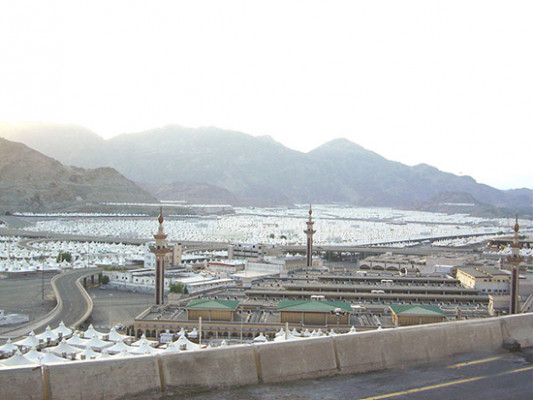
Lesson Description of Hajj (Pilgrimage)
There are three types of Hajj in Islam: 'Ifrad,' 'Qiran,' and 'Tamattu.' The pilgrim chooses one of these three types to perform his Hajj.

Aisha (may Allah be pleased with her) said: "We went with the Messenger of Allah ﷺ and he said: «He who intended among you to put on Ihram for Hajj and Umra should do so. And he who intended to put on Ihram for Hajj may do so. and he who intended to put on Ihram for Umra only may do so.» (Muslim, 1211)
Hajj Tamattu'
Hajj Tamattu: involves performing Umrah during the months of Hajj. When a person wishes to enter into Ihram, he says: “Here I am, O Allah making Umrah leading to Hajj.” After completing the Umrah, the restrictions of Ihram have now been lifted. On the eighth of Dhu al-Hijjah, he puts on his Ihram for Hajj and performs the rites and duties of Hajj until he performs the stoning on the first day of Jamrah on Eid Day. He must then offer the sacrificial animal for Hajj Tamattu. The Quran says: (Whoever avails the advantage of the Umrah along with the Hajj shall make an offering of whatever animal is available.) [Surah Al-Baqarah:196]
(Hajj) Qiran
Hajj Qiran: combines Hajj and Umrah. When a person wishes to enter into ihram, he says: “Here I am, O Allah making Umrah and Hajj.” Upon reaching Mecca, he performs Tawaf al-Qudum. After Tawaf, Sa’i can be performed immediately, or it can be delayed until after the performance of Tawaf al-Ziyarah. He must not perform Halq (shaving the head) or Taqsir (trimming the hair on the head). He should remain in a state of Ihram between Umrah and Hajj and only relinquish it on the day of Nahr (sacrifice, which is on Eid day). An animal sacrifice is required from him.
(Hajj) Ifrad
Hajj Ifrad: involves performing Hajj without Umrah. When entering the state of ihram, he says, “ O Allah, here I am to perform Hajj.” Upon reaching Mecca, he performs Tawaf al-Qudum. After Tawaf, Sa’i can be performed immediately, or it can be delayed until after the performance of Tawaf al-Ziyarah. He must not perform Halq(Shaving the head) or Taqsir (trimming the hair). He should remain in a state of Ihram between Umrah and Hajj and only relinquish it on the 10th of Dhul Hijjah (Yawm al-Nahr). An animal sacrifice is not obligatory for someone doing Hajj Ifrad.
The Muslim must perform Hajj as performed by our Prophet ﷺ and as he commanded his companions (may Allah be pleased with them) to do so. Jabir ( may Allah be pleased with him) reported: I saw the Prophet ﷺ flinging pebbles while riding his camel on the Day of Nahr, and he was saying: «Learn your rituals (by seeing me performing them), for I do not know whether I would be performing Hajj after this Hajj of mine.» (Muslim, 1297)
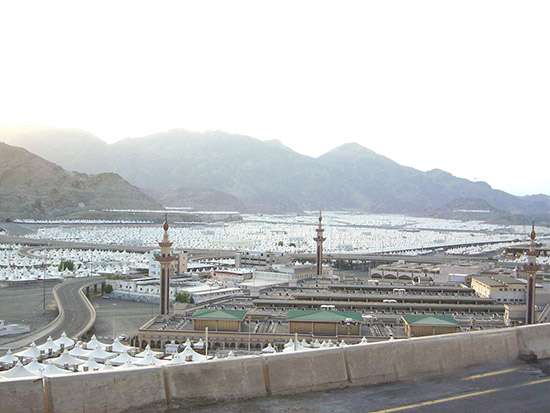
When the pilgrim arrives at the Miqat and wants to enter into the state of Ihram for Hajj, it is recommended for the pilgrim to take his clothes off, make ghusl (bath), wear perfume on his head and beard, put on the Ihram clothes, then pray the obligatory prayer – if it is time – otherwise, pray two Raka’at (unit of prayer) with the intention of performing the sunnah of praying two units for the ritual ablution.

Once he completes his prayer, he should enter into the state of Ihram and, in his mind intend the type of Hajj he desires, then:
He repeats out loud the supplication (talbiyyah): "There is none worthy of worship except Allah alone; no partner has He." The woman repeats it in a way to allow the women next to her can hear but no men. The prohibitions of being in a state of Ihram after entering into it should be avoided.
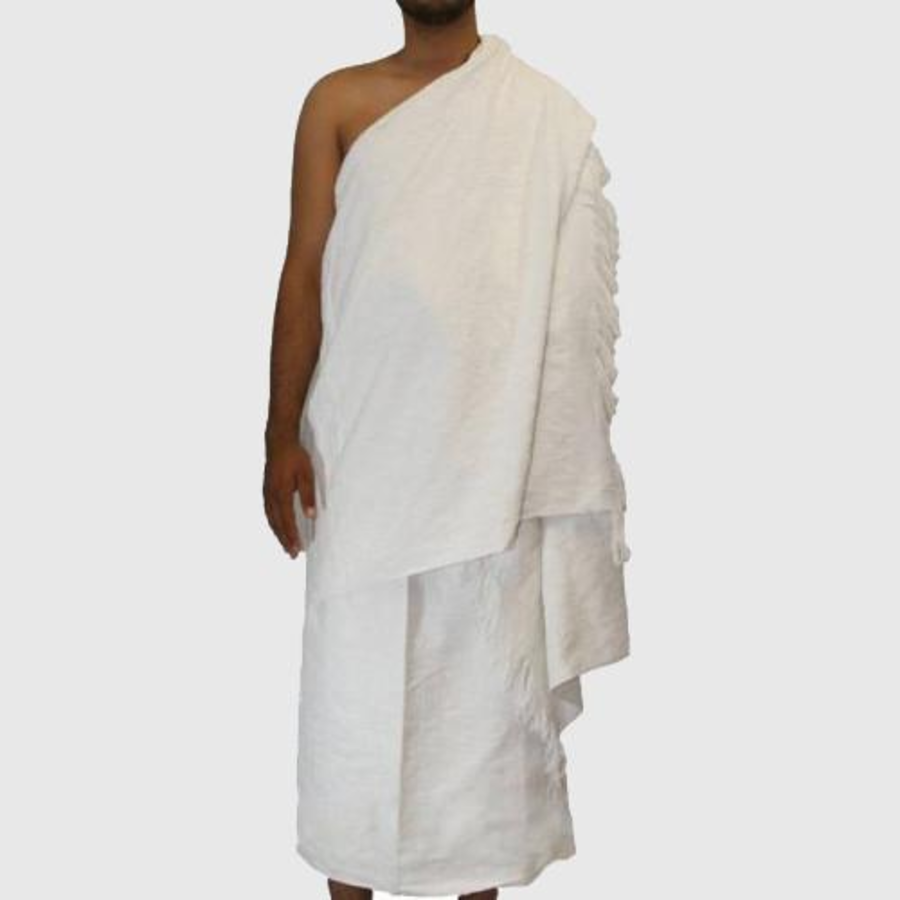
It is recommended that the pilgrim perform a ghusl before entering Makkah. He then heads to the Sacred Mosque to perform Umrah if he is performing Hajj Tamattu. The pilgrim performing Hajj Qiran and Ifrad is recommended to perform Tawaf al-Qudum (circumambulation of arrival)
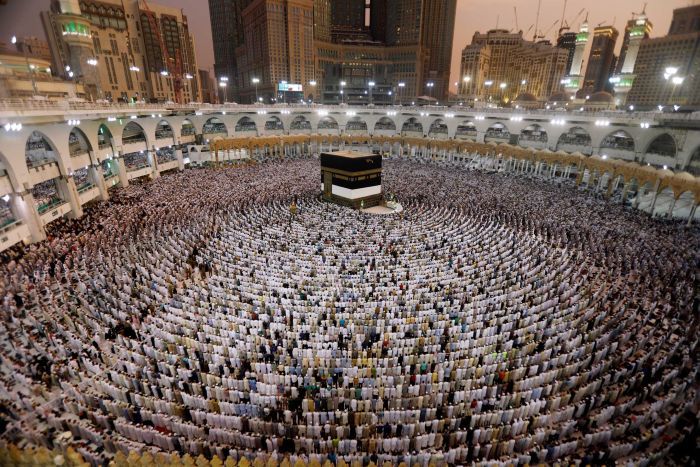
When a pilgrim enters the Sacred Mosque, he puts forth his right foot first and says a supplication to enter the mosque. When he reaches the Kaaba, he stops the supplication (talbiyyah) before he begins the Tawaf. It is recommended for a man to uncover his right shoulder during the arrival tawaf by placing the center of his Ridaa (the towel used to cover the upper torso) under his right armpit and its ends on his left shoulder.
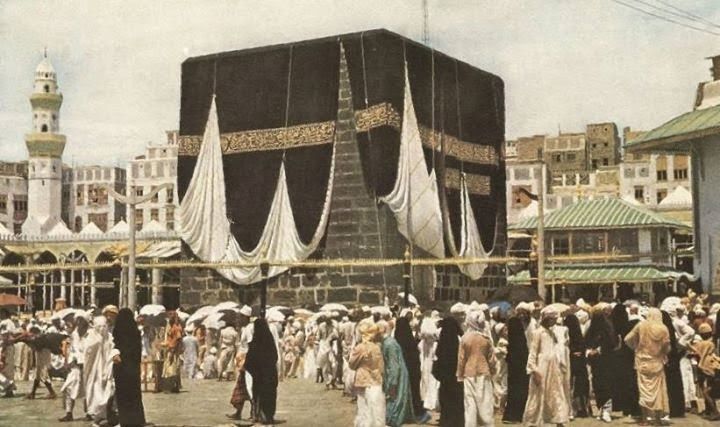
He approaches the Black Stone to start the Tawaf, touches it with his right hand, and kisses it. If this isn't possible, he should face and point to the Black Stone. Then, the pilgrim must walk, keeping the Kaaba on his left. He completes seven circuits of Tawaf, performing Al-Raml (fast-paced walking) during the first three circuits, which means speeding up one's pace with small steps.
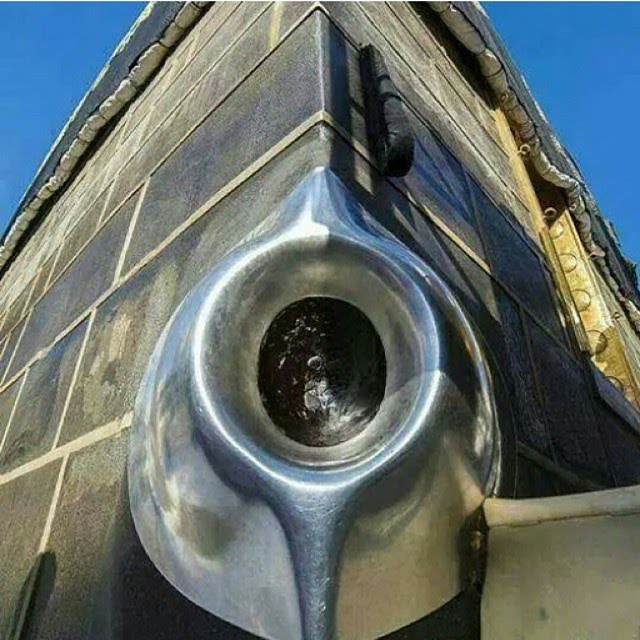
If he reaches the Yemeni corner, he touches it with his hand and does not kiss it; if he cannot feel it, he should not make any sign towards it with his hand. And he should say between the Yemeni corner and the Black Stone: (O our Lord, gives us good in this life, and good in the Hereafter, and save us from the Punishment of the Fire.)

Each time he passes the Black Stone, he should say: "Allah is the Greatest." Then, during the remainder of his Tawaf, he may say what he pleases of supplications, mentioning Allah and reciting the Quran.
When he completes seven circuits of Tawaf, he may return the top half of his ihram cloth to its original state. Then, the pilgrim approaches, if possible, Maqam Ibrahim (station of Ibrahim) or from any place in the Mosque and prays two short Raka’at. During the first raka’ah, he recites, after the first Surah al-Fatiha, Surah Al-Kafirun, and during the second one, Surah Al-lkhlas, after Surah al-Fatiha.
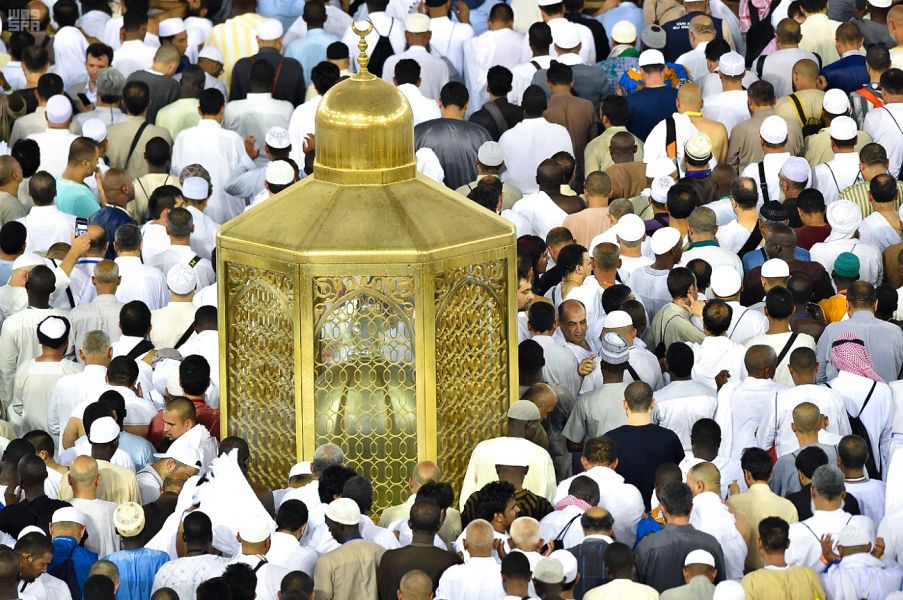
The pilgrim then goes out to the Mesa'a (area of Sa'i), and when he nears Safaa he recites: "Verily Safaa and Marwa are among the shrines of Allah." He says, "We begin with what Allah began with."

He ascends the Sa'i from Safaa, then faces the Kaaba, raises his hands, praises Allah, and makes any supplications he chooses. The Prophet ﷺ supplicated by saying: "There is no god but Allah, alone, without any partner. The Kingdom and praise belong to Him, and He has power over everything," three times, supplicating in between.
He descends Safa and heads towards Marwa at a normal pace until he reaches the green marker. He is then recommended to run fast until the next green marker. Women are not allowed to run between the markers; instead, they should walk at an average pace for the whole duration of the Sa’i.
He continues toward Marwa at a normal pace. When he reaches it, he ascends it, faces the Qibla, raises his hands, and repeats what he said on Safa except that he does not read any Quranic verses or say the words: "I start with what Allah started with,' i.e., Safa.
He continues in this way until he completes seven laps. Going from Safa to Marwa is a lap, and returning is another lap. During his Sa’i, it is recommended to recite what he wills of supplications and recitation of the Quran and to be purified from the major and minor impurities.
The pilgrim performing Hajj Tamattu must perform two sa'is, one for Umrah and another for Hajj. As for the pilgrim performing Hajj Qiran and Ifrad, he must perform one sa'i. After Tawaf, sa'i can be performed immediately, or it can be delayed until after the performance of Tawaf al-Ziyarah.
After completing the sa'i, the pilgrim shaves his head (Halq) or cuts his hair (Taqsir). If the pilgrim is performing Hajj Tamattu, it's best to cut his hair so that some hair will be left for shaving during Hajj. A woman clips her hair the length of a fingertip. With that, Umrah is completed, and everything forbidden to him upon entering Ihram becomes permissible again. If the pilgrim is performing Hajj Qiran or Ifrad, he does not shave his head (Halq) or cut his hair (Taqsir) and should remain in the state of Ihram.

Yawmul Tarwiyyah is the eighth day of Dhu al-Hijjah when the Hajj starts. The pilgrim performing Hajj, Tamattu, purifies himself for Hajj by bathing as he did before Umrah in the place in which he is staying. He performs the ghusl, wears perfume, puts on his Ihram, and says: "Allah, here I am to perform Hajj." As for Hajj Ifrad and Tamattu, the pilgrim is still in the state of Ihram. A pilgrim goes to Mina, and there prays Dhuhr, Asr, Magrib, Isha, and Fajr, shortening his prayers without combining them. He repeats his supplications and reads verses from the Quran.
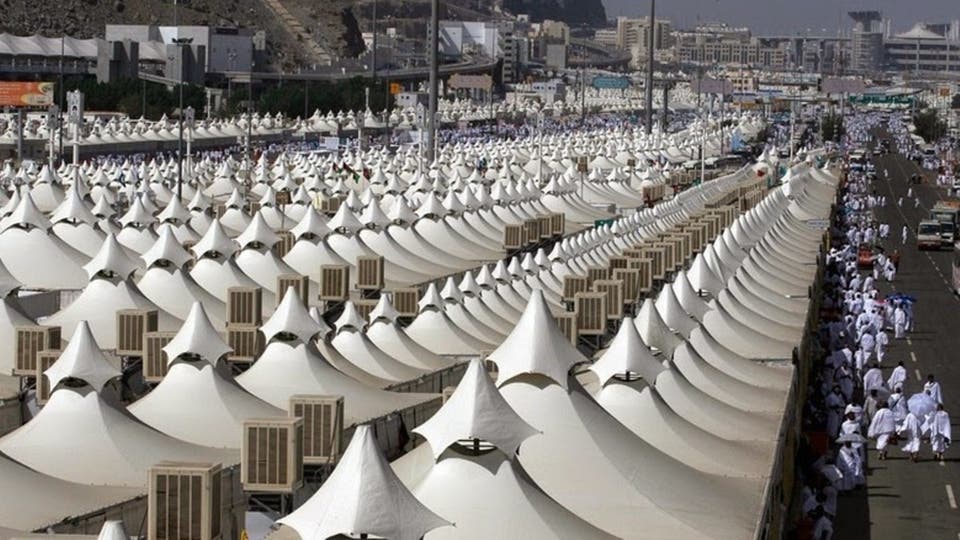
When the sun rises on the Day of Arafah, the ninth day of Dhu al-Hijjah, the pilgrim sets out calmly and serenely from Mina to Arafah while remembering Allah. He is recommended to remain in Namira Mosque until sunset, if possible. Otherwise, he enters Arafah, where he prays Dhuhr and Asr combined at the time of Dhuhr, making each one two Raka’a. Then, he remembers Allah and makes as many supplications as possible while facing the Qibla.
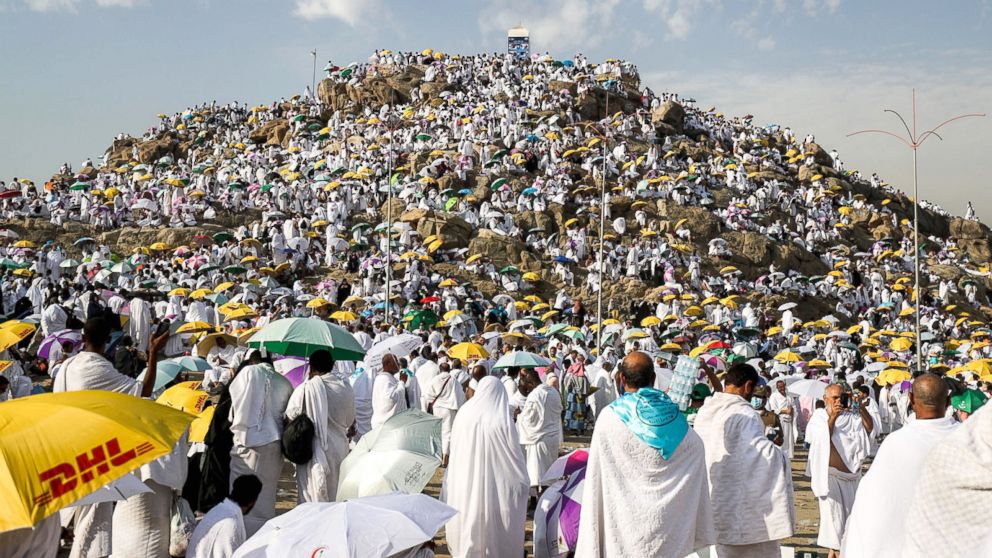
Aisha (may Allah be pleased with her) reported the Prophet ﷺ as saying: «There is no day when Allah sets free more servants from Hell than the Day of 'Arafa. He draws near, then praises them to the angels, saying: What do these people want?» (Muslim, 1348)
The time for standing in 'Arafa starts from midday until sunset. At sunset, the pilgrims make their way from Arafah to Muzdalifah. Therefore, whoever misses this time, and reaches 'Arafa before Fajr on the 10th day, even for a moment, has fulfilled that part of Hajj, and his standing is valid. As for someone who misses the standing before Fajr, he has missed the entire Hajj.
When the pilgrim reaches Muzdalifah, he prays Maghrib and Isha. It is permissible for him to combine the Maghrib and Isha prayers. He remains in Muzdalifah, and when Fajr time starts, he prays Fajr, supplicating and remembering Allah facing the QIbla with his hands raised till just before sunrise.
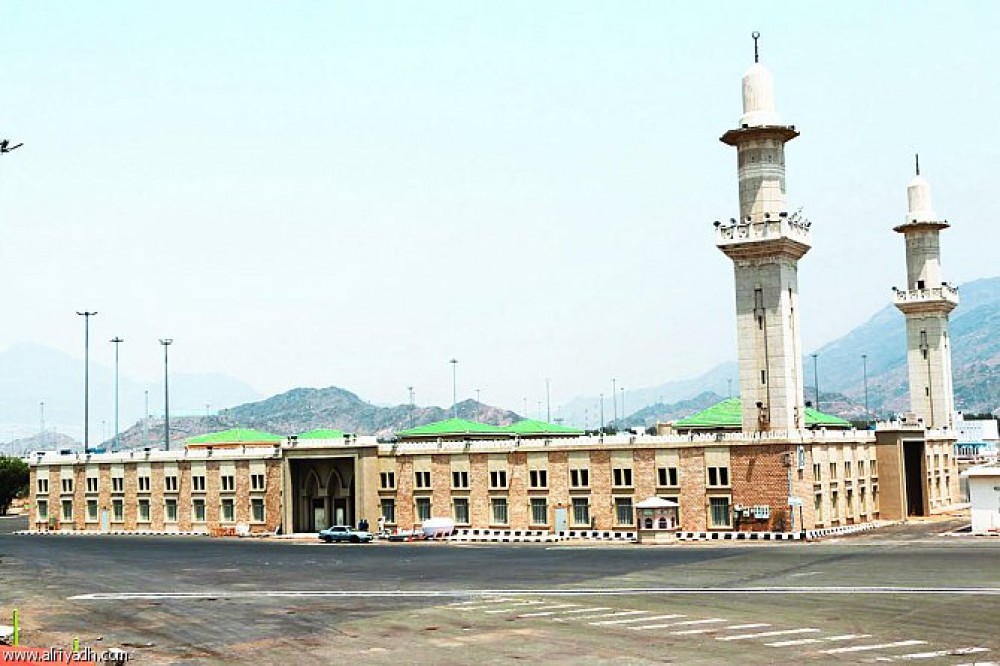
As soon as the light of the day starts on the tenth day of Dhu al-Hijjah and before the sun rises, the pilgrim goes to Mina. Upon reaching it, he collects seven pebbles, slightly larger than a chickpea, and throws them at Jamrah Al-Aqaba, which is the closest one to Mecca, saying: "Allah is the Greatest" as he throws each pebble. Then, he slaughters the sacrificial animal. Next, he shaves or cuts his hair while a woman cuts her hair the length of a fingertip. Finally, it is recommended for the pilgrim to wear perfume and set out to Mecca to perform the Tawaf Al-Ifadhah. Then he returns to Mina to spend the night of the eleventh day of Dhu al-Hijjah.
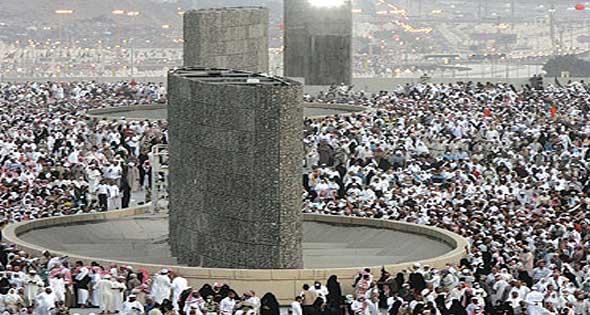
During the days of Tashriq, the pilgrim must stay the nights of the eleventh and twelfth, and on the thirteenth day, he can stay if he wishes to stay behind. He throws stones at the three Jamraat as soon as the sun starts to cause a shadow (afternoon).

How to throw stones at the Jamarat
He starts with the first Jamrah (stone), furthest from Mecca, then the middle stone, and lastly, Jamrah Al-Aqaba. Each one should be stoned with seven consecutive pebbles accompanied by Takbeer (saying Allahu Akbar). He stops after the first and middle Jamrah to make supplications facing the Qibla. Once done throwing the seven pebbles of Jamrah Al-Aqaba, he leaves without making supplications.
After completing the stoning on the twelfth day, he can leave Mina early, and if he wishes, he can stay on the thirteenth night there and stone all three structures as soon as the afternoon starts, as in the previous two days. Staying behind on the thirteenth day is better.
When he is ready to leave Makkah and return to his country, he makes Tawaf Al-Wadaa, which is the last act in Makkah before leaving. Ibn Abbas (may Allah be pleased with them both) narrated: The Messenger of Allah ﷺ said: «No one should depart until he makes as his last act (Tawaf) of the House.» (Muslim, 1327) Menstruating women must not perform Tawaf Al-Wadaa as the obligation is lifted.



